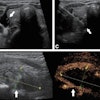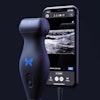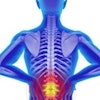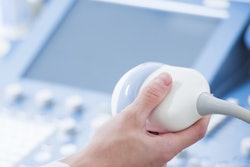
SAN DIEGO - With expanding use of digital imaging resources comes less interaction with patients. But bedside imaging can help salvage that connection, according to a talk given March 14 at the 2022 American Institute of Ultrasound in Medicine (AIUM) annual meeting.
In his presentation, Dr. Abraham Verghese from Stanford University drew from art and history to underline his point about how person-to-person interaction has importance in the medical setting, despite what he called a "digital invasion of our bodies."
"My great hope is that the waning of the bedside exam, even though it has such rich information, can find new life by the burgeoning ultrasound technology," he said. "I hope that all of us can be better at bonding with patients and getting the transformation we want."
Verghese has long championed bedside medicine, being the founding director of the Center for Medical Humanities and Ethics at the University of Texas Health Science Center at San Antonio. That has continued since he arrived at Stanford in 2007. He has also written three books, including My Own Country: A Doctor's Story, The Tennis Partner, and Cutting for Stone.
Verghese went through the history of bedside medicine starting with the invention of percussion as a diagnostic technique by Josef Leopold Auenbrugger. He also referenced Jean-Nicholas Corvisart, who translated Auenbrugger's work; Rene Laennec and his development of the stethoscope; and Sir William Osler's medical education contributions.
"Percussion was the ultrasound of its day," Verghese said.
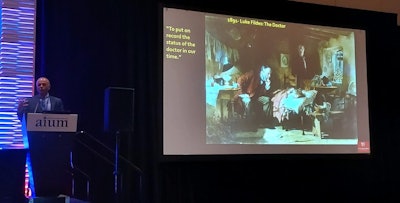 Dr. Abraham Verghese drew from art and history to illustrate the importance of person-to-person care in medicine as medical fields, including radiology, continue to increasingly rely on digital technological resources for patient care. The piece of art he focused on was Luke Fildes' 1891 painting, "The Doctor" and how it shows the relationship between doctor and patient.
Dr. Abraham Verghese drew from art and history to illustrate the importance of person-to-person care in medicine as medical fields, including radiology, continue to increasingly rely on digital technological resources for patient care. The piece of art he focused on was Luke Fildes' 1891 painting, "The Doctor" and how it shows the relationship between doctor and patient.He directed attendees' attention to the 1891 painting, "The Doctor" by Luke Fildes. The painting shows a doctor observing a child patient's illness while a parent looks on. Art critics, as well as Verghese, noted that the painting brings focus to the doctor-patient relationship. The painting was also used in postage stamp form in the '40s by the American Medical Association, which was campaigning against the Truman Administration's proposal for nationalized medical care.
"This painting had an extraordinary effect on the viewing public," Verghese said. "It really struck a chord. My take is despite the title of the painting, this painting has nothing to do with the doctor. I think it appeals to us because you and I identify with that sick child in the center of the painting. This is the kind of singular attentiveness we want from the health system caring for us."
Verghese listed four consequences of decreased doctor-patient connectivity and increased reliance on digital resources. They include patient dissatisfaction, physician and practitioner wellness, medical errors, and loss of ritual.
For the wellness part, Verghese said constant use of digital resources contributes to physician burnout, saying physicians today are "glorified clerical workers." He also said he was shocked to learn that burnout rates at Stanford were "just as bad as anywhere else," and that the university now has a wellness officer to help.
"Our data showed that someone who score high on burnout had a 50-fold chance of leaving the institutions in two years," he said. "There has to be a better way. The Stone Age didn't end because they ran out of stones. The Stone Age ended because they came up with better ideas."
Reimbursement is also affecting the physician-patient relationship, Verghese said. AIUM President Dr. Levon Nazarian echoed the sentiment.
"We need...to resist the trend of commoditizing ultrasound as just another study that we read while seated in a dark room and understand the importance of getting up, scanning, and interacting with patients," Nazarian said. "That part of ultrasound needs to be rewarded, not discouraged. Unfortunately, [healthcare systems] don't reimburse you for that. There has to be an incentive for that."
POCUS is one innovation that Verghese said can help with this cause.
"The beauty of POCUS is you're bringing the technology to the bedside in a meaningful way and there's an opportunity to explain physiology [to patients]," he told AuntMinnie.com.

